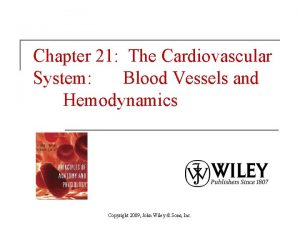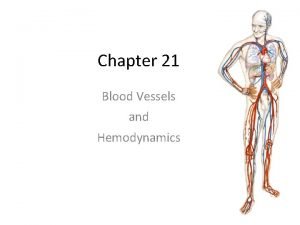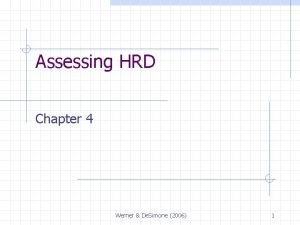The Role of Hemodynamics in Assessing Risk of















- Slides: 15

The Role of Hemodynamics in Assessing Risk of Growth and Rupture of Intracranial Cerebral Aneurysms Warren Chang, MD/MBA, Pablo Villablanca, MD, and Aichi Chien, Ph. D

Modalities for assessment of intracranial hemodynamics • Transcranial doppler: Clinically used primarily for assessment of vasospasm in patients with subarachnoid hemorrhage. Advantages: no radiation, real time imaging. Disadvantages: limited due to bones of cranial vault. Limited field of view. • 4 D Phase Contrast MRA (4 D-Flow): Velocity encoding allows assessment of intracranial hemodynamics. Advantages: No radiation. Relatively short processing time. Extended field of view. Disadvantages: Long acquisition time. • Computational Fluid Dynamics (CFD): Can create theoretical model from data from CTA, DSA, or MR. Advantages: Highest spatial resolution, especially when using DSA data. Disadvantages: Radiation when DSA/CTA used as source data. Long calculation time. Based on assumptions.

Hemodynamic parameters used for assessment of intracranial pathology • Velocity/Flow: This parameter is acquired using velocity encoding in PC-MRA and calculated using CFD. Used to quantify degree of stenosis and derivatives of velocity are used for all hemodynamic analyses. • Streamline analysis: Graphical presentation of vessel flow helps delineate flow patterns and has value in the assessment of flow physiology. Some streamline patterns are associated with increased risk of rupture or hemorrhage. • Wall Shear Stress (WSS): A derivative of velocity, WSS is important due to its effect on endothelial regulation. • Relative pressure: Most significant in stenoses, but may have value in the assessment of aneurysms.

Wall Shear Stress (WSS) is defined as the derivative of velocity with respect to the distance from the wall, multiplied by the viscosity of blood in the vessel. It represents the drag that parallel flowing fluid imposes on the wall as it passes by. Phase Contrast techniques such as PC-VIPR have velocity information that can be used to estimate WSS measurements. High spatial resolution is necessary in order to accurately acquire WSS measurements at the boundary zone near the vessel wall. Figure 1: Relationship between velocity and WSS.

Hemodynamic assessment of intracranial stenosis • Intracranial stenoses are thought to account for approximately 10% of strokes in the US and as many as 50% of strokes worldwide. [1] • Stenoses have also been shown to contribute to aneurysm formation, as shown in Figure 1 (right). • Hemodynamic parameters that can be evaluated in stenoses include flow, velocity, wall shear stress, and pressure gradients. • Streamline analysis may also have value in the evaluation of stenoses. Figure 2: Velocity map showing stenosis and increased velocity in the right vertebral artery with associated basilar artery aneurysm.

Hemodynamic assessment of intracranial stenosis (cont) • Evaluation of wall shear stress (WSS) also has value in the assessment of intracranial stenoses. • Stenoses typically demonstrate high WSS within the stenotic segment and low wall shear stress distal to the stenosis as shown in Figure 2 (right) • Malek et al (1999) [2] demonstrated that low wall shear stress is associated with atherosclerosis. Figure 2: High wall shear stress within the stenotic segment and low distal wall shear stress on a 3 D surface rendered WSS map generated from 4 D PC-MRA data (top) and computational fluid dynamics (bottom)

Hemodynamic assessment of intracranial stenosis (cont) • Evaluation of relative pressure gradients may be useful in evaluating the physiologic effects of stenoses. • Pressure maps can be generated from velocity data from 4 D PC-MRA and CFD. Figure 3: Pressure maps showing pressure drop across a left MCA stenosis map generated from 4 D PC-MRA data (top) and computational fluid dynamics (bottom)

Hemodynamics of intracranial aneurysms • Ruptured intracranial aneurysms (Figure 3, right) result in significant morbidity and mortality [3] however only a small percentage of aneurysms rupture, therefore prognostic information for the evaluation of risk of rupture would be clinically useful. • To date, interval growth, smoking, and size have been identified as risk factors contributing to aneurysm growth and rupture, however hemodynamic parameters may be useful in evaluating risk. • However, the influence of hemodynamics on aneurysm growth and risk of rupture is poorly understood. Figure 4: Digital subtraction angiogram of an internal carotid siphon aneurysm.

Hemodynamic assessment of intracranial aneurysms (cont) Velocity and streamline data help visualize flow patterns which may have value in the evaluation of aneurysms. Several studies have identified flow patterns on streamline analysis that predispose patients to aneurysm rupture. [4 -8] Helical flow patterns that exit the aneurysm sac (left) typically are less concerning than those resulting in an impact zone (right) increasing risk of aneurysm rupture. a) b) Figure 5: a) Streamline map showing a helical flow pattern exiting the aneurysm sac. b) Streamline map showing an impact zone; this morphology is associated with increased risk of aneurysm growth and rupture.

The role of wall shear stress in aneurysms • The effect of wall shear stress on aneurysms is an area of active investigation and is not well understood. • Several investigators have noted that the previously described inflow-jet morphology with high focal WSS is associated with increased risk of rupture [8 -9] • However, other investigators have associated low WSS with endothelial dysregulation and increased risk of rupture. [10 -12]

The role of wall shear stress in aneurysms, cont Figure 6: Wall shear stress and velocity maps of an ICA aneurysm showing inflow jet morphology with elevated wall shear stress at a focal area in the aneurysm dome. DSA image of a similar aneurysm showing the inflow jet. This pattern is associated with increased risk of interval growth and rupture.

The role of pressure in aneurysms While numerous investigators have examined the role of wall shear stress in the growth and rupture of aneurysms, pressure has been less well-studied. One group examined transcatheter pressure measurements during different time points in the cardiac cycle and with differences in heart rate and blood pressure as patients have been shown to rupture aneurysms more commonly during exertion. [8] Time-resolved hemodynamic analysis may have prognostic value given these findings. Figure 7: ACOM aneurysm in a flow phantom showing pressure similar to adjacent arterial feeders.

Morphology in Aneurysm Rupture Risk A number of investigators have examined the morphology of aneurysms to determine whether this has any prognostic value in evaluating the possibility of growth or rupture. Chien et al [14 -15] noted that ruptured aneurysms tended to have higher ratios of aneurysm volume to bounding sphere volume and lower ratios of aneurysm surface to bounding sphere surface. Figure 8: a) Different viewing angles of a basilar trunk aneurysm that was reconstructed from rotational angiography. b) Aneurysm geometry reconstructed by volumetric analysis with CTA images. [14]

Summary • While interval growth, smoking, and hypertension have been shown to be important risk factors for aneurysm rupture, hemodynamic and morphologic assessment of aneurysms may have clinical value. • Wall shear stress analysis, while an active area of investigation, has been shown to have some correlative value in assessment of aneurysms at risk of rupture, especially when coupled with flow morphology. • Pressure measurements, especially when acquired in a time-resolved manner, may have clinical utility. • Morphology of aneurysms may also have predictive value in rupture risk.

References 1. Wong, L. Global burden of intracranial atherosclerosis. International Journal of Stroke 2006: 1: 158– 15 2. Malek A. , Alper S. , and Izumo S. Hemodynamic shear stress and its role in atherosclerosis. JAMA 1999: 282: 2035 -42 3. van Gijn, J. , and Rinkel, G. Subarachnoid haemorrhage: diagnosis, causes and management Brain 2001: 124: 249 -278 4. Kerber, C. , Hecht, S. , Knox, K, et al. Flow dynamics in a fatal aneurysm of the basilar artery. AJNR 1996 17: 1417 -1421 5. Imbesia S. and Kerbera, C. Analysis of Slipstream Flow in Two Ruptured Intracranial Cerebral Aneurysms AJNR 1999 20: 1703 -1705 6. Wetzel S. , Meckel, S. , Frydrychowicz, A. , et al. In Vivo Assessment and Visualization of Intracranial Arterial Hemodynamics with Flow. Sensitized 4 D MR Imaging at 3 T AJNR March 2007 28: 433 -438 7. Cebral J. , Mut F. , Weir J. , et al. Association of hemodynamic characteristics and cerebral aneurysm rupture. AJNR Am J Neuroradiol. 2011: 32: 264 -70 8. Jiang J, Strother CM. Computational fluid dynamics simulations of intracranial aneurysms at varying heart rates: a “patient-specific” study. J Biomech Eng 2009: 131: 91– 101 9. Penn, D. , Komotar, R. , and Connolly, E. Hemodynamic mechanisms underlying cerebral aneurysm pathogenesis Journal of Clinical Neuroscience, Volume 18, Issue 11, November 2011, Pages 1435– 1438 10. Chang, W. , Huang, M. , and Chien, A. Emerging techniques for evaluation of the hemodynamics of intracranial vascular pathology. Neuroradiol J. 2015 Feb; 28(1): 19 -27. 11. Boussel L. , Rayz V. , Mc. Culloch C. , et al. Aneurysm growth occurs at region of low wall shear stress: patient-specific correlation of hemodynamics and growth in a longitudinal study. Stroke 2008: 39: 2997 -3002 12. Raschi M. , Mut F. , Byrne G. , et al. CFD and PIV Analysis of Hemodynamics in a Growing Intracranial Aneurysm. Int j numer method biomed eng. 2012: 28: 214 -228 13. Rayz V. , Boussel L. , Lawton M. , et al. Numerical modeling of the flow in intracranial aneurysms: prediction of regions prone to thrombus formation. Ann Biomed Eng. 2008: 11: 1793 -804 14. Chien A. , Sayre J. , and Viñuela F. Comparative morphological analysis of the geometry of ruptured and unruptured aneurysms. Neurosurgery 2011: 69: 349 -56 15. Chien A and Sayre J. Morphologic and Hemodynamic Risk Factors in Ruptured Aneurysms Imaged before and after Rupture. AJNR Am J Neuroradiol. 2014 Jun 26. [Epub]
 Types of capillaries
Types of capillaries Anaphylactic shock hemodynamics
Anaphylactic shock hemodynamics Collateral circulation vs anastomosis
Collateral circulation vs anastomosis Neurogenic shock symptoms
Neurogenic shock symptoms Sepsis hour 1 bundle
Sepsis hour 1 bundle Hemodynamics made incredibly visual
Hemodynamics made incredibly visual Many new drivers first fender bender is a backing collision
Many new drivers first fender bender is a backing collision Module 4 topic 1 assessing and managing risk
Module 4 topic 1 assessing and managing risk Btec sport unit 3
Btec sport unit 3 Liquidity measures
Liquidity measures Azure web role vs worker role
Azure web role vs worker role Symbolischer interaktionismus krappmann
Symbolischer interaktionismus krappmann Role conflict occurs when fulfilling the role expectations
Role conflict occurs when fulfilling the role expectations Assessing hrd needs
Assessing hrd needs Cultural dynamics in assessing global markets
Cultural dynamics in assessing global markets Assessing motivation to change
Assessing motivation to change




























